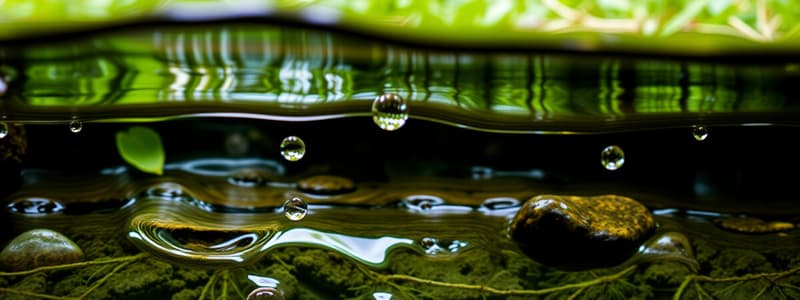Podcast
Questions and Answers
What is the primary reason water has a bent molecular shape?
What is the primary reason water has a bent molecular shape?
- There are forces of attraction between hydrogen molecules.
- Oxygen pulls electrons more strongly than hydrogen. (correct)
- It has a higher boiling point than other substances.
- It is a spherical molecule that collapses under pressure.
What percentage of a living organism's composition can be water?
What percentage of a living organism's composition can be water?
- 60-95% (correct)
- 20-40%
- 40-60%
- 80-100%
Which property of water is primarily attributed to hydrogen bonding?
Which property of water is primarily attributed to hydrogen bonding?
- Its ability to dissolve other substances. (correct)
- Its capacity to conduct electricity.
- Its low freezing point.
- Its high density compared to other liquids.
What is the consequence of water's high specific heat capacity?
What is the consequence of water's high specific heat capacity?
Which of the following statements about adhesion is correct?
Which of the following statements about adhesion is correct?
What does high specific heat capacity of water imply for living organisms?
What does high specific heat capacity of water imply for living organisms?
Which of the following physical properties of water allows it to support the weight of floating objects?
Which of the following physical properties of water allows it to support the weight of floating objects?
How does water's viscosity compare to that of air?
How does water's viscosity compare to that of air?
What biological adaptation might mammals have to cope with high thermal conductivity in water?
What biological adaptation might mammals have to cope with high thermal conductivity in water?
Which factor contributes most to water's high specific heat capacity?
Which factor contributes most to water's high specific heat capacity?
Why do waterborne animals often exhibit features like streamlining and flippers?
Why do waterborne animals often exhibit features like streamlining and flippers?
How does the thermal conductivity of water compare to that of air?
How does the thermal conductivity of water compare to that of air?
Which property of water is responsible for its ability to resist rapid temperature changes?
Which property of water is responsible for its ability to resist rapid temperature changes?
What is the main reason water exhibits high surface tension?
What is the main reason water exhibits high surface tension?
How does adhesion contribute to capillary action in plants?
How does adhesion contribute to capillary action in plants?
Which statement accurately describes hydrophilic substances?
Which statement accurately describes hydrophilic substances?
What role does water's polarity play in its ability as a solvent?
What role does water's polarity play in its ability as a solvent?
What is primarily responsible for the ability of small animals to walk on water?
What is primarily responsible for the ability of small animals to walk on water?
Flashcards are hidden until you start studying
Study Notes
Water as the Medium of Life
- Water has existed on Earth for at least 3.8 billion years, contributing to the planet's development.
- Life began in water, which covers about 70% of Earth's surface.
- Organisms are made up of 60-95% water, depending on the species.
Composition and Structure of Water
- Water is a bent molecule, consisting of one oxygen atom and two hydrogen atoms (H2O).
- Oxygen is slightly negative, while hydrogen is slightly positive, leading to polar covalent bonds.
- Higher electronegativity of oxygen pulls electrons toward it, creating hydrogen bonds among water molecules.
Properties of Water
- Cohesion: Attractive force between identical molecules; hydrogen bonds lead to high surface tension, enabling small animals to walk on water and facilitating water transport in plants via xylem.
- Adhesion: Attractive force between different molecules; allows for capillary action, crucial for water movement in plant stems against gravity.
- Solvent: Water's polarity makes it an excellent solvent for charged or polar substances, forming shells around dissolved particles and disrupting hydrogen bonds.
- Hydrophilic vs. Hydrophobic: Hydrophilic substances (like ions and polar molecules) dissolve well in water, while hydrophobic substances (like oils and large nonpolar molecules) do not. This property is fundamental for cell membrane structure.
Physical Properties of Water
- Specific Heat Capacity: Water has a high specific heat capacity due to extensive hydrogen bonding, requiring considerable energy to increase its temperature, providing stable conditions for organisms.
- Thermal Conductivity: Water effectively transfers heat, with higher thermal conductivity than air, influencing adaptation in waterborne mammals (like the Ringed seal) for heat retention.
- Viscosity: Water's higher viscosity compared to air affects movement; aquatic animals adapt with streamlined bodies and fins to reduce resistance to flow.
- Buoyancy: Upward thrust in water is greater than in air; the density of ice allows it to float, while heavier animals may need structures like ice to support buoyancy.
Biological Implications
- High cohesion results in significant surface tension, supporting small life forms.
- Adhesion enables efficient nutrient and water transport in plants.
- The ability of water to resist temperature changes helps sustain stable aquatic environments, vital for various ecosystems.
- Adaptations in organisms like seals and loons illustrate the physical property differences between air and water, influencing design and survival strategies in different habitats.
Studying That Suits You
Use AI to generate personalized quizzes and flashcards to suit your learning preferences.




